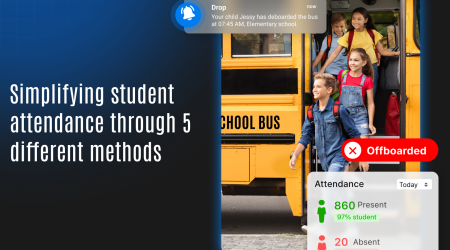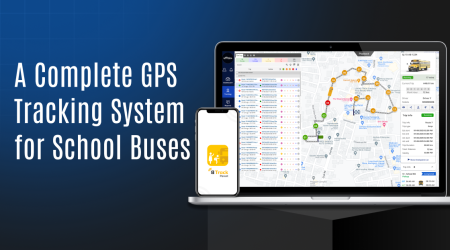How to Efficiently Managing Fleet with Tracking Tools in School Transportation

Efficient fleet management is crucial for any transportation company, especially when it involves the safety of children. A transport company, a leader in school bus services, has set a benchmark in efficiently managing fleet operations through the use of comprehensive tracking tools. In this case study, we’ll delve into how the transport company has revolutionized their operations, enhanced safety, and improved overall efficiency using advanced school bus monitoring software.
The Need for Efficient Fleet Management
Efficient fleet management goes beyond just knowing where your vehicles are at any given time. It involves ensuring safety, optimizing routes, reducing fuel consumption, and maintaining vehicle health. For the transport company, another company responsible for transporting thousands of school children daily, these factors are paramount.
Challenges Faced by the transport company
Before adopting advanced tracking tools, the transport company encountered several issues common in fleet management. These included:
- Route Inefficiencies: School buses often traveled inefficient routes, leading to longer travel times and increased fuel costs.
- Safety Concerns: Without real-time tracking, ensuring the safety of students on board was challenging.
- Communication Gaps: Drivers and management faced difficulties in maintaining seamless communication.
- Vehicle Maintenance: Keeping up with regular maintenance schedules was cumbersome, often leading to unexpected breakdowns.
Route Inefficiencies
One of the most pressing challenges for the transport company was the inefficient routes taken by their school buses. Often, buses would travel longer distances than necessary due to a lack of optimized routing. This inefficiency not only extended the travel time for students but also resulted in higher fuel consumption and increased operational costs. The inability to adapt to changing traffic conditions further exacerbated this problem, leading to delays and frustration for both students and parents.
Safety Concerns
Safety is a top priority for any school transport service. However, without real-time tracking, the transport company struggled to ensure the safety of students on board. There were instances where buses deviated from their designated routes, and without immediate knowledge of these deviations, the management couldn’t take timely action. Additionally, monitoring driver behavior was nearly impossible, making it challenging to enforce safe driving practices consistently.
Communication Gaps
Effective communication between drivers and management is essential for smooth operations. the transport company faced significant communication gaps, which hindered their ability to respond promptly to unexpected situations. Drivers often had to rely on mobile phones to communicate with the central office, leading to delays and miscommunication. This lack of seamless communication also affected coordination during emergencies, further compromising student safety.
Vehicle Maintenance
Regular vehicle maintenance is crucial for ensuring the reliability and safety of school buses. However, the transport company found it difficult to keep up with maintenance schedules manually. This often led to unexpected breakdowns, disrupting services and causing inconvenience to students and parents. The lack of a systematic approach to vehicle maintenance also meant higher repair costs and reduced vehicle lifespan.
These challenges not only affected operational efficiency but also raised concerns among parents regarding the safety of their children.
Implementing Comprehensive Tracking Tools
To address these issues, the transport company turned to advanced school bus routing software. This software offered a range of features designed to enhance fleet management and safety.
Key Features of the Tracking Tools:
- Real-Time GPS Tracking: Allows management to monitor the exact location of each bus in real-time.
- Geofencing: Alerts when buses enter or leave predefined areas, ensuring students are picked up and dropped off at the correct locations.
- Route Optimization: Analyzes traffic conditions and suggests the most efficient routes.
- Driver Behavior Monitoring: Tracks driving habits such as speed, harsh braking, and idling, promoting safer driving practices.
- Maintenance Alerts: Notifies management of upcoming maintenance needs based on mileage and engine hours.
Real-Time GPS Tracking
Real-time GPS tracking was a game-changer for the transport company. This functionality empowered management to track the exact whereabouts of every bus in real-time.By having real-time visibility, they could ensure that buses were following their designated routes and make immediate adjustments if necessary. Parents also benefited from this feature, as they could track the location of the bus and get accurate arrival times.
Geofencing
Geofencing allowed the transport company to set predefined geographic boundaries for their buses. Whenever a bus entered or exited these boundaries, the system would send instant alerts to the management. This feature ensured that students were picked up and dropped off at the correct locations. It also provided an additional layer of security, as any unauthorized route deviations were immediately flagged for review.
Route Optimization
The route optimization feature analyzed real-time traffic data and suggested the most efficient routes for the buses. By avoiding traffic congestion and selecting the shortest paths, the transport company significantly reduced travel times and fuel consumption. This optimization not only improved punctuality but also contributed to cost savings. Additionally, the ability to quickly adapt to changing traffic conditions minimized delays and ensured a smoother journey for students.
Driver Behavior Monitoring
Monitoring driver behavior was essential for promoting safe driving practices. The software tracked various driving habits, such as speed, harsh braking, and idling. By analyzing this data, the transport company could identify risky behaviors and provide targeted training to drivers. This proactive approach helped reduce accidents and ensured that drivers adhered to safety protocols. Parents felt more confident knowing that the drivers were being monitored and held accountable for their actions.
Maintenance Alerts
Keeping up with vehicle maintenance became much more manageable with automated maintenance alerts. The system notified the management of upcoming maintenance needs based on mileage and engine hours. This proactive approach prevented unexpected breakdowns and ensured that the buses were always in optimal condition. Regular maintenance also extended the lifespan of the vehicles, resulting in lower repair costs and improved reliability.
Benefits of Efficiently Managing Fleet with Tracking Tools
The introduction of comprehensive tracking tools brought about numerous benefits for the transport company. Let’s break down these advantages:
- Enhanced Safety:
- Real-time tracking and geofencing provided peace of mind to parents and ensured students’ safety.
- Monitoring driver behavior helped reduce accidents and promote responsible driving.
- Operational Efficiency:
- Route optimization reduced travel times and fuel consumption, leading to cost savings.
- Enhanced connectivity between drivers and management resulted in more efficient coordination across operations.
- Maintenance Management:
- Proactive maintenance alerts prevented unexpected breakdowns and extended the lifespan of the buses.
- Regular maintenance schedules ensured the buses were always in optimal condition.
- Cost Savings:
- Reduced fuel consumption and maintenance costs contributed to overall financial savings.
- Efficient routes and fewer breakdowns meant fewer operational disruptions.
Enhanced Safety
Safety is the cornerstone of the transport company’s operations. The real-time tracking and geofencing features ensured that students were always safe during their commute.Parents were able to monitor the bus’s location in real-time and receive notifications about any deviations from the planned route. The driver behavior monitoring system further enhanced safety by encouraging drivers to adhere to safe driving practices. The combined effect of these features was a significant reduction in accidents and incidents, providing parents with peace of mind.
Operational Efficiency
The introduction of route optimization had a profound impact on the transport company’s operational efficiency. By identifying the most efficient routes and adapting to real-time traffic conditions, the company reduced travel times and fuel consumption. This efficiency translated into cost savings and improved service reliability. Efficient communication between drivers and management was pivotal in improving coordination and promptly addressing any issues that arose.
Maintenance Management
Proactive maintenance alerts ensured that the buses were always in top condition. By staying ahead of maintenance needs, the transport company prevented unexpected breakdowns and minimized service disruptions. Regular maintenance schedules extended the lifespan of the buses, reducing repair costs and improving overall reliability. This systematic approach to maintenance management was instrumental in maintaining a high level of service quality.
Cost Savings
The combination of reduced fuel consumption, lower maintenance costs, and efficient routes resulted in substantial cost savings for the transport company. By optimizing their operations and minimizing unnecessary expenses, the company achieved financial sustainability. These savings allowed the transport company to reinvest in their fleet and further improve their services.
Real-World Outcomes for the transport company
The implementation of these tracking tools has had a profound impact on the transport company’s operations. Here are some real-world outcomes they experienced:
- Improved Punctuality:
- Buses adhered to schedules more consistently, reducing wait times for students and parents.
- Timely arrivals and departures became the norm, enhancing the company’s reliability.
- Increased Safety Records:
- A noticeable reduction in accidents and incidents due to better monitoring of driver behavior.
- Parents reported feeling more secure knowing the buses were being closely monitored.
- Operational Transparency:
- Enhanced visibility into daily operations allowed for better decision-making and planning.
- Management could quickly address any issues that arose, minimizing disruptions.
- Higher Parent Satisfaction:
- Positive feedback from parents who appreciated the increased safety measures and timely service.
- Greater trust in the transport company’s ability to safely transport their children.
Improved Punctuality
The introduction of route optimization and real-time tracking led to a significant improvement in punctuality. Buses were able to adhere to schedules more consistently, reducing wait times for students and parents. Timely arrivals and departures became the norm, enhancing the transport company’s reliability. This punctuality was crucial for building trust with parents and ensuring a smooth daily routine for students.
Increased Safety Records
The comprehensive tracking tools resulted in a noticeable reduction in accidents and incidents. By closely monitoring driver behavior and providing real-time location updates, the transport company was able to enforce safe driving practices and respond quickly to any issues. Parents reported feeling more secure knowing that the buses were being monitored closely. This increase in safety records played a vital role in enhancing the company’s reputation.
Operational Transparency
Enhanced visibility into daily operations allowed the transport company’s management to make informed decisions and plan more effectively. The ability to monitor real-time data and receive timely alerts enabled quick responses to any issues that arose. This operational transparency minimized disruptions and ensured that the company could maintain a high level of service quality. It also facilitated better communication with parents, who appreciated the transparency in operations.
Higher Parent Satisfaction
The improvements in safety, punctuality, and operational transparency led to higher parent satisfaction. Positive feedback from parents reflected their appreciation for the increased safety measures and timely service. The trust that parents placed in the transport company’s ability to safely transport their children was a testament to the company’s commitment to excellence. This higher level of satisfaction was instrumental in building a loyal customer base and promoting word-of-mouth referrals.
Key Takeaways for Other Transport Companies
For other transport companies looking to improve their fleet management, the transport company’s success offers valuable insights:
- Invest in Advanced Tracking Tools:
- The benefits of real-time tracking, route optimization, and driver behavior monitoring cannot be overstated.
- Focus on Safety:
- Prioritize features that enhance safety, such as geofencing and driver behavior monitoring.
- Optimize Routes:
- Use technology to find the most efficient routes, reducing travel times and fuel consumption.
- Proactive Maintenance:
- Implement systems that alert you to maintenance needs before they become critical issues.
- Communicate Effectively:
- Ensure seamless communication between drivers and management to address issues promptly.
Invest in Advanced Tracking Tools
Investing in advanced tracking tools is crucial for any transport company aiming to improve their fleet management. The benefits of real-time tracking, route optimization, and driver behavior monitoring are immense. These features not only enhance operational efficiency but also ensure the safety of passengers. By adopting comprehensive tracking tools, transport companies can gain a competitive edge and provide a higher level of service to their clients.
Focus on Safety
Safety should always be a top priority. Features such as geofencing and driver behavior monitoring play a vital role in ensuring the safety of passengers. By implementing these features, transport companies can prevent accidents, enforce safe driving practices, and provide peace of mind to their clients. A focus on safety also helps build trust and enhances the company’s reputation.
Optimize Routes
Route optimization is essential for reducing travel times and fuel consumption. By using technology to find the most efficient routes, transport companies can achieve cost savings and improve service reliability. Route optimization also minimizes delays and ensures timely arrivals and departures, which are crucial for maintaining a high level of customer satisfaction.
Proactive Maintenance
Proactive maintenance is key to preventing unexpected breakdowns and ensuring the reliability of the fleet. Implementing systems that alert you to maintenance needs before they become critical issues helps extend the lifespan of vehicles and reduce repair costs. Regular maintenance schedules also contribute to overall operational efficiency and service quality.
Communicate Effectively
Effective communication between drivers and management is essential for smooth operations. Ensuring seamless communication helps address issues promptly and minimizes disruptions. It also facilitates better coordination during emergencies and enhances overall service reliability. By prioritizing effective communication, transport companies can improve their operational efficiency and customer satisfaction.
Conclusion: Transforming Fleet Management with Technology
The transport company’s journey in efficiently managing their fleet using comprehensive tracking tools is a testament to the power of technology in modern transportation. By addressing their challenges head-on with advanced school bus monitoring software, they have not only improved their operational efficiency but also set a new standard for safety and reliability in school transport services.
For any transport company aiming to enhance their fleet management practices, investing in the right tracking tools is crucial. By learning from the transport company’s experience, you can take the first step towards transforming your fleet operations and providing safer, more efficient services to your clients.


